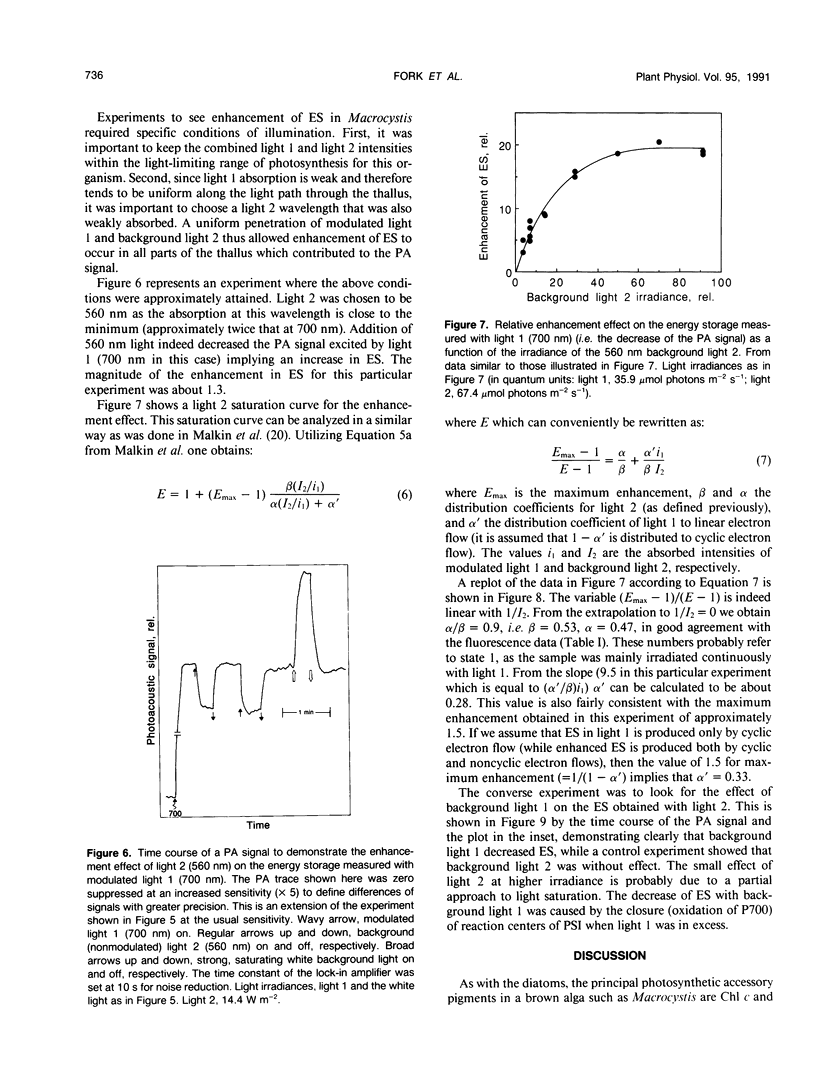Abstract
The brown alga Macrocystis pyrifera (giant kelp) was studied by a combination of fluorescence spectroscopy at 77 kelvin, room temperature modulated fluorimetry, and photoacoustic techniques to determine how light energy is partitioned between photosystems I and II in states 1 and 2. Preillumination with farred light induced the high fluorescence state (state 1) as determined by fluorescence emission spectra measured at 77K and preillumination with green light produced a low fluorescence state (state 2). Upon transition from state 1 to state 2, there was an almost parallel decrease of all of the fluorescence bands at 693, 705, and 750 nanometers and not the expected decrease of fluorescence of photosystem II and increase of fluorescence in photosystem I. The momentary level of room temperature fluorescence (fluorescence in the steady state, Fs), as well as the fluorescence levels corresponding to all closed (Fm) or all open (Fo) reaction-center states were measured following the kinetics of the transition between states 1 and 2. Calculation of the distribution of light 2 (540 nanometers) between the two photosystems was done assuming both the `separate package' and `spill-over' models. Unlike green plants, red algae, and cyanobacteria, the changes here of the light distribution were rather small in Macrocystis so that there was approximately an even distribution of the photosystem II light at 540 nanometers to photosystem I and photosystem II in both states 1 and 2. Photoacoustic measurements confirmed the conclusions reached as a result of fluorescence measurements, i.e. an almost equal distribution of light-2 quanta to both photosystems in each state. This conclusion was reached by analyzing the enhancement phenomenon by light 2 of the energy storage measured in far red light. The effect of light 1 in decreasing the energy storage measured in light 2 is also consistent with this conclusion. The photoacoustic experiments showed that there was a significant energy storage in light 1 which could be explained by cyclic electron transport around photosystem I. From a quantitative analysis of the enhancement effect of background light 2 (maximum enhancement of 1.4-1.5) it was shown that around 70% of light 1 was distributed to this cyclic photosystem I transport.
Full text
PDF








Selected References
These references are in PubMed. This may not be the complete list of references from this article.
- Bonaventura C., Myers J. Fluorescence and oxygen evolution from Chlorella pyrenoidosa. Biochim Biophys Acta. 1969;189(3):366–383. doi: 10.1016/0005-2728(69)90168-6. [DOI] [PubMed] [Google Scholar]
- Canaani O., Barber J., Malkin S. Evidence that phosphorylation and dephosphorylation regulate the distribution of excitation energy between the two photosystems of photosynthesis in vivo: Photoacoustic and fluorimetric study of an intact leaf. Proc Natl Acad Sci U S A. 1984 Mar;81(6):1614–1618. doi: 10.1073/pnas.81.6.1614. [DOI] [PMC free article] [PubMed] [Google Scholar]
- HAXO F. T., BLINKS L. R. Photosynthetic action spectra of marine algae. J Gen Physiol. 1950 Mar;33(4):389–422. doi: 10.1085/jgp.33.4.389. [DOI] [PMC free article] [PubMed] [Google Scholar]
- Herbert S. K., Fork D. C., Malkin S. Photoacoustic measurements in vivo of energy storage by cyclic electron flow in algae and higher plants. Plant Physiol. 1990 Nov;94(3):926–934. doi: 10.1104/pp.94.3.926. [DOI] [PMC free article] [PubMed] [Google Scholar]
- Lasser-Ross N., Malkin S., Cahen D. Photoacoustic detection of photosynthetic activities in isolated broken chloroplasts. Biochim Biophys Acta. 1980 Dec 3;593(2):330–341. doi: 10.1016/0005-2728(80)90070-5. [DOI] [PubMed] [Google Scholar]
- Ley A. C., Butler W. L. Effects of Chromatic Adaptation on the Photochemical Apparatus of Photosynthesis in Porphyridium cruentum. Plant Physiol. 1980 Apr;65(4):714–722. doi: 10.1104/pp.65.4.714. [DOI] [PMC free article] [PubMed] [Google Scholar]
- Malkin S., Kok B. Fluorescence induction studies in isolated chloroplasts. I. Number of components involved in the reaction and quantum yields. Biochim Biophys Acta. 1966 Nov 8;126(3):413–432. doi: 10.1016/0926-6585(66)90001-x. [DOI] [PubMed] [Google Scholar]
- Murata N. Control of excitation transfer in photosynthesis. I. Light-induced change of chlorophyll a fluorescence in Porphyridium cruentum. Biochim Biophys Acta. 1969 Feb 25;172(2):242–251. doi: 10.1016/0005-2728(69)90067-x. [DOI] [PubMed] [Google Scholar]
- Murata N. Control of excitation transfer in photosynthesis. IV. Kinetics of chlorophyll a fluorescence in Porphyra yezoensis. Biochim Biophys Acta. 1970 Jun 30;205(3):379–389. doi: 10.1016/0005-2728(70)90104-0. [DOI] [PubMed] [Google Scholar]
- Owens T. G. Light-Harvesting Function in the Diatom Phaeodactylum tricornutum: II. Distribution of Excitation Energy between the Photosystems. Plant Physiol. 1986 Mar;80(3):739–746. doi: 10.1104/pp.80.3.739. [DOI] [PMC free article] [PubMed] [Google Scholar]
- Smith B. M., Melis A. Photosystem Stoichiometry and Excitation Distribution in Chloroplasts from Surface and Minus 20 Meter Blades of Macrocystis pyrifera, the Giant Kelp. Plant Physiol. 1987 Aug;84(4):1325–1330. doi: 10.1104/pp.84.4.1325. [DOI] [PMC free article] [PubMed] [Google Scholar]


